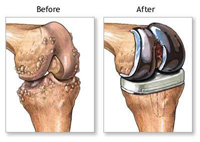By Amy Norton
NEW YORK |
Tue Jun 12, 2012
3:22am IST
NEW YORK (Reuters Health) - Injections of
the lubricating substance hyaluronic acid may be little help to people with knee
arthritis, researchers reported Monday.
Hyaluronic acid exists naturally in the fluids that bathe the joints, where
it acts like a shock absorber and lubricant. People with osteoarthritis -- the
common, "wear-and-tear" type of arthritis -- seem to have lower-than-normal
levels.
So one treatment for arthritis patients is to get injections of hyaluronic
acid directly into the affected joint, a therapy also known as
viscosupplementation. In the United States, it's been approved since 1997 for
knee arthritis only; in Europe, it's been used longer and for more types of
arthritis.
But a new research review, published in the Annals of Internal Medicine,
finds the benefits may be minimal for aching knees.
Looking at 89 past clinical trials, researchers found that overall,
viscosupplementation did seem to bring pain relief to some knee arthritis
sufferers -- as compared to "sham" injections or no treatment.
But when they focused on 18 larger trials (with at least a couple hundred
patients), there were only "clinically irrelevant" effects, according to the
researchers.
On top of that, they report, the injections can carry side effects like
swelling and inflammation in the joint soon after treatment.
"We don't have evidence that viscosupplementation works, but it is associated
with an increased risk of adverse events," said Dr. Peter Juni from the
University of Bern in Switzerland, who worked on the study.
"That is not very reassuring," Juni told Reuters Health. He and his
colleagues recommend that the injections "be discouraged" for people with knee
arthritis.
But an orthopedic surgeon not involved in the study said hyaluronic acid
injections should still be an option for at least some patients.
"I think patient selection is key," said Dr. Joseph Bosco, from the NYU
Langone Medical Center in New York.
The injections are more likely to help someone with mild to moderate knee
arthritis and "no big pieces of cartilage floating around in the joint,"
according to Bosco. (Osteoarthritis occurs when the cartilage cushioning the
ends of the bones begins to break down.)
Bosco also pointed to the limitations of the new study.
It's what researchers call a "meta-analysis," which means the results of
different studies are pooled together. The issue, Bosco said, is that the
individual studies differ from each other -- in how they are done, the specific
hyaluronic acid formulations and characteristics of the patients.
"I think it's difficult to make an overarching comment on the use of
hyaluronic acid, based on this," Bosco said.
In general, the evidence on hyaluronic acid is not high-quality, according to
Dr. John Richmond, who chaired the committee that devised the current treatment
guidelines on knee arthritis from the American Academy of Orthopedic
Surgeons.
But he agreed the therapy should remain an option. "It's a reasonable way to
manage pain" for at least some people, Richmond, also the head of orthopedics at
New England Baptist Hospital in Boston, said in an interview.
MANY OPTIONS, NO SURE THING
In the early stages of knee arthritis, people may be able to go with non-drug
options alone, like exercise or, if needed, weight loss. And pain relievers such
as acetaminophen might help.
But when that no longer works, people often arrive at a place where they are
"stuck," Richmond said.
Most commonly, they turn to non-steroidal anti-inflammatory drugs (NSAIDs) --
painkillers like ibuprofen, naproxen and the prescription drug celecoxib
(Celebrex).
But both Richmond and Bosco pointed out that regularly using those drugs has
significant downsides, such as stomach irritation in some people.
Injections of cortisone, which fight inflammation, can bring a temporary
reprieve. But those should not be done repeatedly, Richmond said.
The final resort is surgery to replace part or all of the damaged knee joint.
But, Richmond and Bosco said, that may not be appropriate for younger, more
active people.
"Hyaluronic acid is no panacea," Bosco said. But, he added, "I think it
should be kept in physicians' armamentarium" against knee arthritis."
In the U.S., the injections are approved for knee arthritis that cannot be
managed with non-drug tactics and simple analgesics like acetaminophen or
topical rubs.
When they work, the injections -- which involve anywhere from one to five
separate shots, depending on the formulation -- offer only temporary pain
relief. You might feel better for a few months, then need a repeat round of
shots.
Based on what's known so far, repeated rounds of treatment appear safe,
Richmond said.
But that gets pricey. With all costs and fees considered, one round of
treatment approaches $1,000, according to Richmond. (In the U.S., Medicare and
many private insurers will at least partly pay.)
As for safety, some studies in the current review looked at "serious adverse
events" -- including life-threatening conditions or problems severe enough to
land someone in the hospital.
Only eight studies actually described those events, which were more common in
viscosupplementation patients -- 26 suffered serious problems, versus 14
patients in the untreated groups.
But those "events" included cases of cancer, cardiovascular disease and
musculoskeletal disorders. And Bosco and Richmond both doubted those problems
could be pinned on hyaluronic acid injections.
The trials typically lasted four months. Attributing something like cancer to
the injections "doesn't make a whole lot of sense," Richmond said.
Juni said there is an "unfortunate" lack of both safe and effective options
for people with knee arthritis. But he also urged people with the condition to
"not be too pessimistic."
He said the basic approaches to knee arthritis, like exercise therapy and
losing excess weight, can help ease symptoms in many people, if they stick with
them.
The study was funded by the Arco Foundation, a private research
organization.
SOURCE:
bit.ly/atTzv0 Annals of Internal
Medicine, online June 11, 2012.










